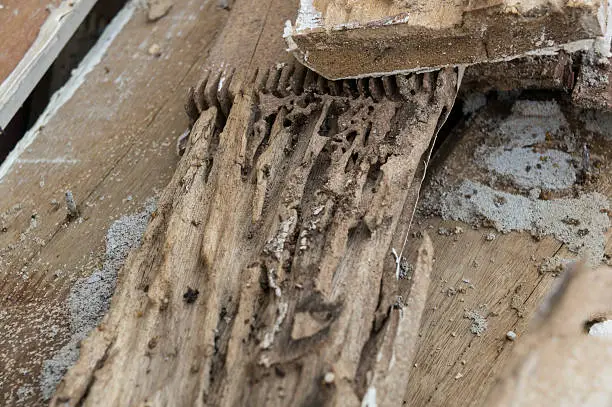

Termites cannot survive at temperatures above 120 degrees Fahrenheit. Heat treatment utilizes specialized equipment to gradually raise the internal temperature of your property to between 120 and 130 degrees Fahrenheit. This elevated temperature is maintained for approximately four hours, ensuring that all termites—no matter where they are hiding—are completely exterminated. Strategically placed fans distribute heat evenly throughout the structure, effectively reaching deep into walls, floors, and other hidden areas where termites thrive.
Heat treatment is an innovative and efficient method for eliminating termites. Unlike traditional pesticide applications, heat treatment penetrates deep into structural areas, ensuring complete eradication. One of the key benefits of this method is its speed—treatments are typically completed within 4-6 hours, allowing you to return to your home or business the same day. This approach is particularly appealing for those seeking an eco-friendly, chemical-free solution that is safe for children, pets, and individuals with chemical sensitivities.

Technicians at Southland Pest Control are highly trained and state-licensed, ensuring they have the expertise to handle any termite infestation effectively. Continuous education and training keep them updated on the latest pest control methods.
After the initial termite treatment, we offer follow-up services to monitor the effectiveness of the treatment and address any recurring issues. Regular check-ups ensure a long-term solution to termite problems.
Experience Top-Quality Pest Control & Prevention – Safe, Effective, and Long-Lasting!
Keep your home pest-free with Southland Pest Control’s reliable and customized solutions for all types of unwanted intruders.
Protect your property from costly termite damage with Southland Pest Control’s advanced detection and treatment solutions
Say goodbye to rats, mice gophers and squirrels with Southland Pest Control’s expert rodent removal and prevention services.
Protect your home and family from the nuisance and health risks of mosquitoes with Southland Pest Control's effective and eco-friendly mosquito control solutions

Fumigation is a highly effective method for eliminating widespread termite infestations. The structure is sealed with a tent for 24-48 hours while Vikane gas is introduced, replacing oxygen and penetrating deep into walls, attics, and hidden spaces. Once the treatment is complete, our technicians air out the structure and conduct a thorough inspection before allowing occupants to return. This treatment is backed by a 3-year warranty for long-term protection.
Orange oil is a natural, eco-friendly solution that eliminates termites without using traditional pesticides. It works by injecting orange oil directly into exposed wood, killing termites and their eggs on contact. This quick and non-invasive treatment allows you to remain in your home during the process, making it a popular alternative to chemical-based methods.


For smaller infestations, localized spot treatments provide a targeted and cost-effective solution. After inspecting the affected areas, our technicians apply a specialized treatment directly to the infested wood. This method requires little to no preparation and does not require evacuating the home, making it a convenient option for homeowners dealing with isolated termite activity.
Before the heat treatment begins, our licensed technicians conduct a thorough inspection to assess the severity of the infestation. If heat treatment is the best option, we will schedule the service at a convenient time. On the day of treatment, our team sets up heating equipment and carefully monitors temperature levels throughout the process. Once the treatment is complete, we inspect the property to confirm the termites have been eradicated. Finally, the structure is ventilated to restore normal indoor temperatures, making it safe for re-entry.
Heat treatment offers several key advantages over traditional fumigation and spot treatments. It is an environmentally friendly, non-chemical solution that eliminates termites in a single session without leaving behind toxic residues. Unlike fumigation, heat treatment does not require extensive preparation or extended vacating of the property, minimizing disruption to your daily routine. If you are looking for a fast, effective, and chemical-free way to eliminate termites, contact us today to schedule a consultation.

Structural defects make homes more vulnerable to damage from natural disasters like earthquakes and storms. These defects can arise from design flaws, poor construction, or the weakening of wood due to pests such as termites, beetles, fungi, and carpenter ants. Left unchecked, these pests can reduce the strength of wood by up to 80%, significantly increasing the risk of severe damage. For example, a porch column with a masonry exterior may appear sturdy, but hidden termite damage inside could cause it to collapse under pressure. Regular home maintenance and pest inspections are crucial to preserving structural integrity. Opening inaccessible areas for inspection can help detect and address hidden termite damage before it becomes a major issue.
Termites are highly skilled at finding wood, even when it is hidden beneath concrete, soil, or stucco. Several conditions can make structures more vulnerable to termite infestations. Cracks in concrete foundations provide termites with hidden entry points to wooden structures. Soil in direct contact with wood, such as buried fence posts, wooden porch steps resting on soil, or concrete porches filled with soil, offers easy access for these pests. Unresolved moisture problems, including poor drainage, leaking pipes, or overgrown vegetation blocking ventilation, create ideal conditions for termites to thrive. Additionally, wood sources like tree stumps, buried form boards, wood chip mulch, and firewood stacked on the ground can attract termites, allowing them to spread to nearby structures. A professional inspection by Southland Pest Control can identify these and other risk factors, helping to prevent costly termite damage.
Our team is fully trained and licensed to secure your home from invasive termites.
We make pest control simple, effective, and hassle-free.
Here’s what you can expect when working with Southland Pest Control:
Our expert technicians thoroughly inspect your property to identify pest activity, entry points, and risk factors.
We use industry-leading, family- and pet-safe treatments to eliminate pests without harming the environment.
We offer follow-up services, preventative treatments, and expert advice to keep pests from coming back.
We develop a targeted solution based on the type of infestation, property layout, and your specific needs.
Our team applies treatments strategically for maximum effectiveness, ensuring long-lasting protection.
Your peace of mind is our priority! We stand behind our services with warranties and customer support.

Copyright © 2025 Southland Pest Control. All rights reserved.
Pest Control Marketing by Streamline Results